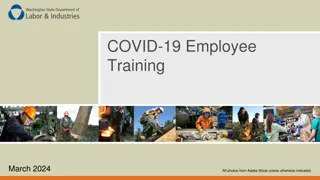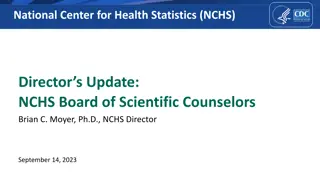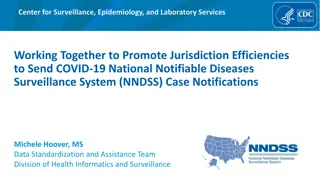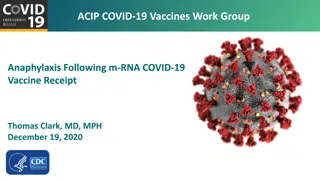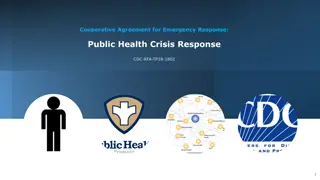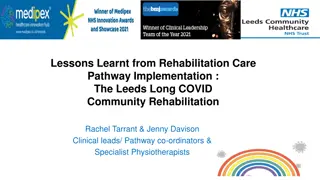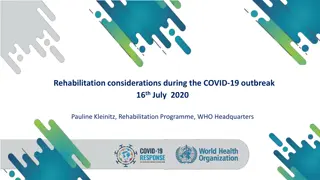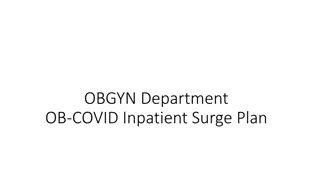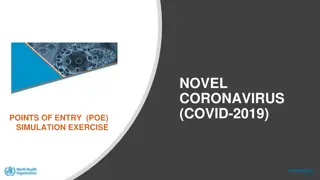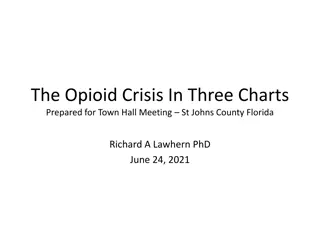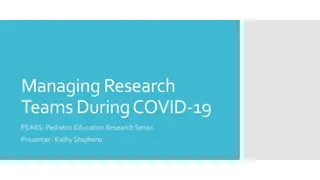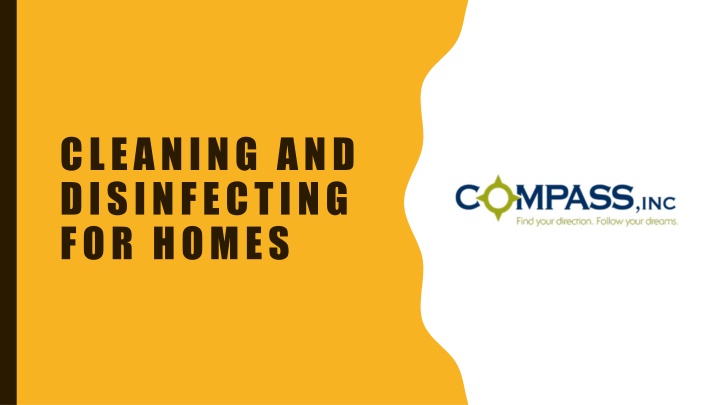
Effective Cleaning and Disinfecting Practices for Homes
Learn about the importance of cleaning and disinfecting surfaces in homes to prevent the spread of COVID-19. Understand the differences between cleaning and disinfecting, best practices for each, and how to properly clean high-touch surfaces. Discover how ventilation plays a role in reducing the risk of transmission indoors.
Download Presentation

Please find below an Image/Link to download the presentation.
The content on the website is provided AS IS for your information and personal use only. It may not be sold, licensed, or shared on other websites without obtaining consent from the author. If you encounter any issues during the download, it is possible that the publisher has removed the file from their server.
You are allowed to download the files provided on this website for personal or commercial use, subject to the condition that they are used lawfully. All files are the property of their respective owners.
The content on the website is provided AS IS for your information and personal use only. It may not be sold, licensed, or shared on other websites without obtaining consent from the author.
E N D
Presentation Transcript
CLEANING AND DISINFECTING FOR HOMES
WHAT WE ALREADY KNOW ABOUT CORONA VIRUS/ COVID-19 Spread from person-to-person of this virus happens most frequently among close contacts (within about 6 feet) This type of transmission occurs via respiratory droplets. Recent studies indicate that people who are infected but do not have symptoms likely also play a role in the spread of COVID-19. Current evidence suggests that SARS-CoV-2 may remain viable for hours to days on surfaces made from a variety of materials. Cleaning of visibly dirty surfaces followed by disinfection is a best practice measure for prevention of COVID-19 and other viral respiratory illnesses in households and community settings.
WHAT WE KNOW CONTINUED It is unknown how long the air inside a room occupied by someone with confirmed COVID-19 remains potentially infectious. Homes will need to consider factors such as the size of the room and the ventilation system design (including flowrate [air changes per hour] and location of supply and exhaust vents) when deciding how long to close off rooms or areas used by ill persons before beginning disinfection. Taking measures to improve ventilation in an area or room where someone was ill or suspected to be ill with COVID-19 will help shorten the time it takes respiratory droplets to be removed from the air.
HOMES WITH SUSPECTED OF CONFIRMED CASES
THIS GUIDANCE OF CLEANING AND DISINFECTING IS AIMED AT LIMITING THE SURVIVAL OF THE VIRUS IN THE ENVIRONMENT. Disinfecting refers to using chemicals, for example, EPA-registered disinfectants, to kill germs on surfaces. This process does not necessarily clean dirty surfaces or remove germs, but by killing germs on a surface after cleaning, it can further lower the risk of spreading infection. Cleaning refers to the removal of germs, dirt, and impurities from surfaces. It does not kill germs, but by removing them, it lowers their numbers and the risk of spreading infection.
CLEAN Cleaning with soap and water reduces number of germs,dirt and impurities on the surface.Disinfecting kills germs on surfaces. Practice routine cleaning of frequently touched surfaces. High touch surfaces include: Clean surfaces using soap and water, then use disinfectant. Wear disposable gloves to clean and disinfect. Tables, doorknobs, light switches, countertops, handles, desks, phones, keyboards, toilets, faucets, sinks, etc.
DISINFECT Recommend use of EPA-registered household disinfectant. Read labels: Follow the instructions on the label to ensure safe and effective use of the product. Many products recommend: Keeping surface wet for a period of time (see product label) Precautions such as wearing gloves and making sure you have good ventilation during use of the product
Diluted household bleach solutions may also be used if appropriate for the surface. Check the label to see if your bleach is intended for disinfection, and ensure the product is not past its expiration date. Some bleaches, such as those designed for safe use on colored clothing or for whitening may not be suitable for disinfection. DISINFECT WITH BLEACH SOLUTION Unexpired household bleach will be effective against coronaviruses when properly diluted. Follow manufacturer s instructions for application and proper ventilation. Never mix household bleach with ammonia or any other cleanser. Leave solution on the surface for at least 1 minute.
BLEACH SOLUTION: Prepare a bleach solution by mixing: 01 5 tablespoons (1/3rd cup) bleach per gallon of water or 02 4 teaspoons bleach per quart of water
ROUTINE CLEANING AND DISINFECTING OF HOMES Everyone should practice routine cleaning of frequently touched surfaces with household cleaners and EPA-registered disinfectants that are appropriate for the surface, following label instructions. tables, doorknobs, light switches, handles, desks, toilets, faucets, sinks, and electronics Read labels
Follow the manufacturers instructions for all cleaning and disinfection products. Consider use of wipeable covers for electronics. FOR ELECTRONICS If no manufacturer guidance is available, consider the use of alcohol-based wipes or spray containing at least 70% alcohol to disinfect touch screens. Dry surfaces thoroughly to avoid pooling of liquids.
DISINFECTION FOR HOME ISOLATION- CONFIRMED COVID-19 Household members should educate themselves about COVID-19 symptoms and preventing the spread of COVID-19 in homes. Clean and disinfect high-touch surfaces daily in household common areas (e.g.tables, hard-backed chairs, doorknobs, light switches, phones, tablets, touch screens, remote controls, keyboards, handles, desks, toilets, sinks) In the bedroom/bathroom dedicated for an ill person: consider reducing cleaning frequency to as-needed (e.g., soiled items and surfaces) to avoid unnecessary contact with the ill person. As much as possible, an ill person should stay in a specific room and away from other people in their home, following home care guidance.
CONTINUED If a separate bathroom is not available, the bathroom should be cleaned and disinfected after each use by an ill person. The staff should wait as long as practical after use by an ill person to clean and disinfect the high-touch surfaces. Housemates and staff should follow home care guidance when interacting with persons with suspected/confirmed COVID-19 and their isolation rooms/bathrooms.
HARD (NON-POROUS) SURFACES Wear disposable gloves when cleaning and disinfecting surfaces. Gloves should be discarded after each cleaning. If reusable gloves are used, those gloves should be dedicated for cleaning and disinfection of surfaces for COVID-19 and should not be used for other purposes. Consult the manufacturer s instructions for cleaning and disinfection products used.Clean hands immediately after gloves are removed. If surfaces are dirty, they should be cleaned using a detergent or soap and water prior to disinfection. Use EPA registered household disinfectant or diluted household bleach solutions can be used if appropriate for the surface.
CONTINUED Follow manufacturer s instructions for application, Ensuring a contact time of at least 1 minute Allowing proper ventilation during and after application Check to ensure the product is not past its expiration date. Never mix household bleach with ammonia or any other cleanser. Unexpired household bleach will be effective against coronaviruses when diluted.
SOFT (POROUS) SURFACES For soft (porous) surfaces such as carpeted floor, rugs, and drapes, remove visible contamination if present and clean with appropriate cleaners indicated for use on these surfaces. After cleaning: Launder items as appropriate in accordance with the manufacturer s instructions. If possible, launder items using the warmest appropriate water setting for the items and dry items completely. Otherwise, use products that are EPA-approved for use against the virus that causes COVID-19pdf iconexternal icon and that are suitable for porous surfaces.
ELECTRONICS For electronics such as cell phones, tablets, touch screens, remote controls, and keyboards, remove visible contamination if present. Follow the manufacturer s instructions for all cleaning and disinfection products. Consider use of wipeable covers for electronics. If no manufacturer guidance is available, consider the use of alcohol-based wipes or sprays containing at least 70% alcohol to disinfect touch screens. Dry surfaces thoroughly to avoid pooling of liquids.
HAND HYGIENE AND OTHER PREVENTIVE MEASURES Household members and staff should clean hands often, including immediately after removing gloves and after contact with an ill person, by washing hands with soap and water for 20 seconds. If soap and water are not available and hands are not visibly dirty, an alcohol- based hand sanitizer that contains at least 60% alcohol may be used. However, if hands are visibly dirty, always wash hands with soap and water. Household members should follow normal preventive actions while at work and home including recommended hand hygiene and avoiding touching eyes, nose, or mouth with unwashed hands.
ADDITIONAL KEY TIMES TO CLEAN HANDS INCLUDE After blowing one s nose, coughing, or sneezing After using the restroom Before eating or preparing food After contact with animals or pets Before and after providing routine care for another person who needs assistance
OTHER CONSIDERATIONS The ill person should eat/be fed in their room if possible. Non- disposable food service items used should be handled with gloves and washed with hot water or in a dishwasher.Clean If possible, dedicate a lined trash can for the ill person. Use gloves when removing garbage bags, handling, and disposing of trash.Wash hands after handling or disposing of trash. Clean hands Wash hands Clean hands hands after handling used food service items.
CLEAN AND DISINFECT YOUR HOME THE SAME WAY.
BEFORE YOU COME TO WORK PUT A CHANGE OF FRESHLY LAUNDERED CLOTHES AND SHOES FOR EVERY SHIFT IN A BAG. HAVE A SEPARATE BAG TO PUT CONTAMINATED CLOTHES AFTER YOU CHANGE. HAVE YOUR FACEMASK IN A SANDWICH BAGGIE TO PREVENT CONTAMINATION. TAKE A SHOWER AND WASH YOUR HANDS WITH SOAP AND WATER FOR AT LEAST 20 SECONDS.
WHEN YOU ARRIVE TO WORK PUT ON YOUR MASK BEFORE ENTERING THE HOME. BRING INSIDE YOUR BAG WITH YOUR FRESH CLOTHES AND YOUR EMPTY BAG FOR YOUR CONTAMINATED CLOTHES. GO TO THE DESIGNATED STAFF CHANGING ROOM AND CHANGE INTO THE FRESHLY LAUNDERED CLOTHES AND SHOES YOU BROUGHT. PUT THE COME BACK INSIDE AND WASH YOUR HANDS WITH SOAP AND WATER FOR AT LEAST 20 SECONDS. CLOCK IN CLOTHES/SHOES YOU WERE WEARING INTO THE CONTAMINATION BAG AND PUT IT IN THE TRUNK OF YOUR CAR.
WHEN YOU ARE ARRIVING AT YOUR HOME. Take off the clothes/shoes you are currently wearing. Wash all clothes in the contamination bag and the clothes you were just wearing. Leave shoes outside to air out overnight or spray with Lysol. Take a shower and wash your hands with soap and water for at least 20 seconds. Hand wash your cloth mask and let it air dry.
CARING FOR SOMEONE SUSPECTED OR POSITIVE FOR COVID-19
FOLLOW THESE RECOMMENDATIONS IF SOMEONE: Has been tested, are awaiting results, and the person has been asked to quarantine in their room. Has symptoms of COVID-19. Has tested positive of COVID-19.
SYMPTOMS MAY APPEAR 2 2- -14 DAYS AFTER EXPOSURE THE VIRUS. THE VIRUS. PEOPLE WITH THESE SYMPTOMS OR COMBINATIONS OF SYMPTOMS MAY HAVE COVID-19: 14 DAYS AFTER EXPOSURE TO TO Cough Shortness of breath or difficulty breathing Or at least two of these symptoms: Fever Chills Repeated shaking with chills Muscle pain Headache Sore throat New loss of taste or smell **Staff should stay home and contact their supervisor if they are experiencing symptoms of COVID-19 **
Immediately notify the nurse of symptoms observed, elevated temperatures and fevers. Delegating Nurse may recommend the following: Nursing video assessment FOLLOW NURSE NOTIFICATION POLICY Pushing fluids PRN fever reducer Urgent care visit Calling 911 Contacting PCP other
EMERGENCY POLICY : WHEN TO SEEK MEDICAL ATTENTION If you have any of these emergency warning signs* for COVID-19 get medical attention immediately: Trouble breathing Persistent pain or pressure in the chest New confusion or inability to arouse Bluish lips or face *This list is not all inclusive. Please consult your medical provider for any other symptoms that are severe or concerning to you. Call 911 if you have a medical emergency:Notify the operator that you have, or think you might have, COVID-19. If possible, put on a cloth face covering before medical help arrives.
PROVIDE SUPPORT AND HELP COVER BASIC NEEDS Follow Nursing Care Plan Help the person who is sick follow their doctor s instructions for care and medicine. Administer PRN for fever if directed by the DN. Acetaminophen (sometimes called Tylenol), help the person feel better. (this also requires a doctor s prescription) Make sure the person who is sick drinks a lot of fluids and rests. Help them with grocery shopping, filling prescriptions, and getting other items they may need. Consider having the items delivered by someone outside of the home, if possible. For most people, symptoms last a few days, and people usually feel better after a week.
WATCH FOR WARNING SIGNS Have their doctor s phone number and the designated nurse s number on hand. Consult with the Delegating Nurse if there is any changes in symptoms. Call their doctor if the person keeps getting sicker. For medical emergencies, call 911 and tell the dispatcher that the person has or might have COVID-19. People who have emergency warning signs for COVID-19 should call 911 right away. Then call your supervisor. Emergency warning signs include*: Difficulty breathing or shortness of breath Persistent pain or pressure in the chest New confusion or inability to wake up Bluish lips or face *This is not every emergency symptom or sign.*
PROTECT YOURSELF AND OTHERS WHEN CARING FOR SOMEONE WHO IS SICK
LIMIT CONTACT: COVID-19 SPREADS BETWEEN PEOPLE WHO ARE IN CLOSE CONTACT (WITHIN ABOUT 6 FEET) THROUGH RESPIRATORY DROPLETS, CREATED WHEN SOMEONE TALKS, COUGHS OR SNEEZES. The staff, when possible,should not be someone who is at higher risk for severe illness from COVID-19. Use a separate bedroom and bathroom. If possible, have the person who is sick stay in their own sick room or area and away from others. If possible, have the person who is sick use a separate bathroom. Shared space: If you have to share space, make sure the room has good air flow. Open the window and turn on a fan (if possible) to increase air circulation. Improving ventilation helps remove respiratory droplets from the air. Avoid having visitors.Avoid having any unnecessary visitors, especially visits by people who are at higher risk for severe illness.
EAT IN SEPARATE ROOMS OR AREAS Stay separated: The person who is sick should eat (or be fed) in their room, if possible. Wash dishes and utensils using gloves and hot water: Handle any dishes, cups/glasses, or silverware used by the person who is sick with gloves. Wash them with soap and hot water or in a dishwasher. Clean hands Clean hands after taking off gloves or handling used items.
AVOID SHARING PERSONAL ITEMS Do not share: dishes, cups/glasses, silverware, towels, bedding, or electronics (like a cell phone) with the person who is sick.
WHEN TO WEAR A FACE COVER OR GLOVES
SICK PERSON: SICK PERSON: The person who is sick should wear a face covering when they are around other people at home and out (including before they enter a doctor s office). The face covering helps prevent a person who is sick from spreading the virus to others. It keeps respiratory droplets contained and from reaching other people.
STAFF: Wear gloves when you touch or have contact with the sick person s blood, stool, or body fluids, such as saliva, mucus, vomit, and urine. Throw out gloves into a lined trash can and wash hands right away. The staff should ask the sick person to put on a face covering before entering the room. Staff should wear a face covering when caring for a person who is sick.
Wash hands:Wash your hands often with soap and water for at least 20 seconds. Tell everyone in the home to do the same, especially after being near the person who is sick. CLEAN YOUR HANDS OFTEN Hand sanitizer:If soap and water are not readily available, use a hand sanitizer that contains at least 60% alcohol. Cover all surfaces of your hands and rub them together until they feel dry. Hands off:Avoid touching your eyes, nose, and mouth with unwashed hands.
BEDROOM AND BATHROOM If you are using a separate bedroom and bathroom: Only clean the area around the person who is sick when needed, such as when the area is soiled. This will help limit your contact with the sick person. If they feel up to it, the person who is sick can clean their own space. If it is appropriate for that person, give the person who is sick personal cleaning supplies such as tissues, paper towels, cleaners, and EPA-registered disinfectantsexternal icon. If sharing a bathroom: The person who is sick should clean and then disinfect after each use. If this is not possible, wear a mask and wait as long as possible after the sick person has used the bathroom before coming in to clean and use the bathroom.
WASH AND DRY LAUNDRY Dirty laundry from a person who is sick can be washed with other people s items. Wear disposable gloves while handling dirty laundry. Do not shake dirty laundry. Wash items according to the label instructions. Use the warmest water setting you can. Remove gloves, and wash hands right away. Dry laundry, on hot if possible, completely. Wash hands after putting clothes in the dryer. Clean and disinfect clothes hampers. Wash hands afterwards.
USE LINED TRASH CAN Place Place used disposable gloves and other contaminated items in a lined trash can. Use Use gloves when removing garbage bags, and handling and disposing of trash. Wash hands afterwards. Place Place all used disposable gloves, facemasks, and other contaminated items in a lined trash can. Dedicate If possible, dedicate a lined trash can for the person who is sick.
TRACK YOUR OWN HEALTH Notify HR Staff and close contacts should monitor their health for COVID-19 symptoms. Symptoms include fever, cough, and shortness of breath but other symptoms may be present as well. Trouble breathing is a more serious warning sign that you need medical attention. Use CDC s self-checker tool to help you make decisions about seeking appropriate medical care. If you are having trouble breathing, call 911. Call your doctor or emergency room and tell them your symptoms before going in. They will tell you what to do.
I N H O M E I N H O M E I S O L ATIO N I S O L ATIO N
They have had no fever for at least 72 hours (that is three full days of no fever without the use of medicine that reduces fevers) AND ISOLATION CAN ISOLATION CAN BE REMOVED BE REMOVED AFTER THESE THREE THINGS HAVE HAPPENED: other symptoms have improved (for example, symptoms of cough or shortness of breath have improved) AND at least 10 days have passed since their symptoms first appeared
IF THEY HAVE HAD A TEST IF THEY HAVE HAD A TEST TO DETERMINE IF THEY ARE STILL CONTAGIOUS, THEY CAN LEAVE HOME AFTER THESE THREE THINGS HAVE HAPPENED: They no longer have a fever (without the use of medicine that reduces fevers) AND other symptoms have improved (for example, symptoms of cough or shortness of breath have improved) AND they have received two negative tests in a row, at least 24 hours apart. Their doctor will follow CDC guidelines.
PEOPLE WHO DID NOT HAVE COVID PEOPLE WHO DID NOT HAVE COVID- -19 SYMPTOMS, BUT TESTED POSITIVE AND HAVE STAYED HOME (HOME ISOLATED) POSITIVE AND HAVE STAYED HOME (HOME ISOLATED) CAN LEAVE HOME UNDER THE FOLLOWING CONDITIONS**: 19 SYMPTOMS, BUT TESTED If they have not had a test to determine if they are still contagious, they can leave home after these two things have happened: At least 10 days have passed since the date of their first positive test AND they continue to have no symptoms (no cough or shortness of breath) since the test. If they have had a test to determine if they are still contagious, they can leave home after: They have received two negative tests in a row, at least 24 hours apart. Their doctor will follow CDC guidelines.
FOR ALL PEOPLE PPE GUIDANCE
FOR ALL PEOPLE **In all cases,follow the guidance of your designated nurse, doctor, and local health department.The decision to stop home isolation should be made in consultation with their healthcare provider and state and local health departments. Some people, for example those with conditions that weaken their immune When leaving the home,keep a distance of 6 feet from others and wear a face face covering face covering covering when around other people. weaken their immune system, weaken their immune system, system,might continue to shed virus even after they recover.**
PERSONAL PROTECTIVE EQUIPMENT DO S AND DON TS DO DON T Wash your hands between interactions with residents Snap your gloves as this may aerosol the virus. Correctly wear a cloth or medical mask, goggles, or face shields. And disinfect them. Touch the outside of your PPE. Wash hands before and after touching. Conserve PPE for staff working with symptomatic residents Wear gloves outside of resident care areas. Wipe your skin with medical grade disinfectants. Wear gloves while cleaning with medical grade disinfectants.


